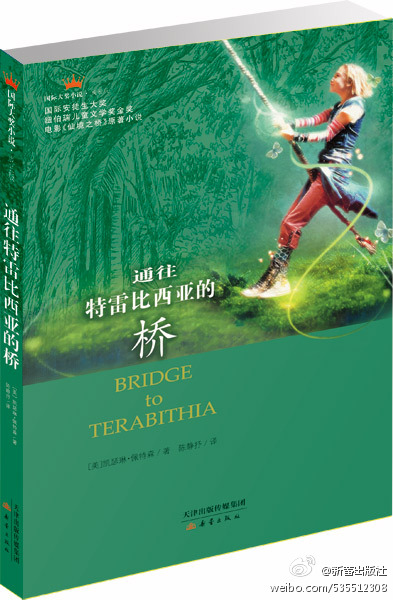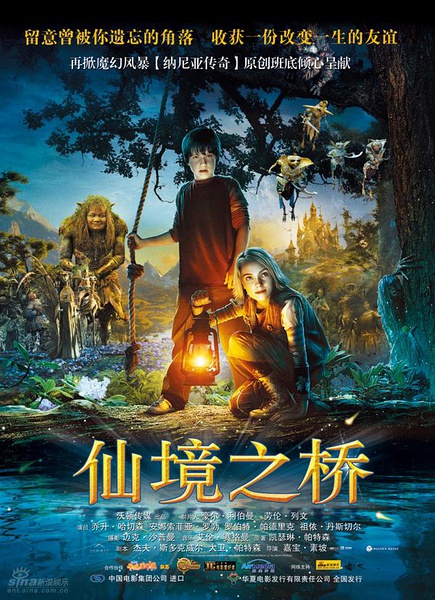One day, a friend excitedly told me that he’d stumbled upon a children’s film on CCTV‑6 a few days earlier and thought it was fantastic. He’d only just started watching it midway through, so he couldn’t remember the name. This was a friend I greatly respected for his refined taste, so I curiously asked, “What was the story?” He explained that the protagonists were a boy and a girl who often spent time in a forest, imagining it as their own fantasy kingdom. One day, the girl went there alone and tragically fell into a river and drowned.…I said I knew, that story was “Bridge to Terabithia”(literal translation of the English name), and the author is the American writer Katherine who was born in China·Patterson, because there are only a few people in the world who can write such a good story.
I later found and watched that movie, it was really great. The Chinese translation is “Bridge to Terabithia”. This is a recent Disney adaptation, adding more fantasy elements and special effects. The story development is also more exciting, probably more in line with the tastes of the audience of this era. However, I still prefer1977The story in the novel is more soothing and calm, the characters are more full-bodied, leaving more room for thought, and it will deeply shock readers and leave them with a long aftertaste.
As someone who often deals with words, I particularly admire Patterson’s ability to control words with simplicity and clarity. She can contain as much meaning as possible in a few words, which is not only clear but also powerful. For example, on the first page of the novel, from the sound of the father’s pickup truck starting up to the description of Jesse’s sneakers, and then to the description of the children’s bed arrangements, readers have already learned that Jesse’s family is very poor financially; and from the simple exchanges between Jesse and his sister, we know that it was very early, that their mother had a bad temper, and even more so, the deep friendship between the two siblings; of course, we also know Jesse’s ambitions.——Be the fastest runner in the fifth grade. And then the story moves on. Patterson’s writing is like that; readers need to savor every description and every line of dialogue, as she seems unwilling to waste a single unnecessary word. So, while this novel isn’t long, it’s incredibly engaging.
The psychological portrayals of the young boys and girls in the novel felt particularly real and relatable to me. The protagonist, Jesse, is not perfect. He is kind and responsible, loves drawing, and possesses a remarkable imagination. However, he also possesses the narrow-mindedness and timidity of an unworldly country boy, particularly lacking confidence and a spirit of adventure. In contrast, Leslie’s personality and abilities are quite complete, but she comes from a family of progressive writers and feels alienated from the local culture. After several setbacks, she becomes increasingly withdrawn, becoming somewhat cynical about her classmates and teachers, resulting in only a handful of friends at school. The other characters, whether their families, classmates, or teachers, seem equally imperfect. This is precisely one of the reasons I particularly enjoy the novel.
Catherine’s own upbringing was not perfect. She lived in China with her missionary parents as a child and spoke Chinese. During the Japanese invasion of China, they also fled everywhere. When she was eight years old, she had to flee back to the United States. After that, the whole family continued to move around. It is said that she18I moved with my parents before I was 18.18She is the third of five siblings in a family. Her older siblings are of similar age, and her two younger sisters are also very close. She is often alone in the middle, which is very similar to Jessie who has two older sisters and two younger sisters. When she went to school, she couldn’t speak the language at first, and later she changed schools frequently. She also had a mediocre life. In her own words, when she was a child,“Cowardly, unintelligent, clumsy, the kind of person who can never be a hero”. So, when she later became a writer, she especially wanted to write books for children who were also often dejected, timid and fearful. It is also very special to say that when she grew up, Catherine also became a missionary, and she went to Japan, which she once hated very much. There, she became close friends with many Japanese. She returned to the United States, got married, had children, and adopted two children, becoming a mother of four children. She also taught in a rural school, which was almost the same as the Skye Creek Elementary School in the novel. The children in the class she taught were similar to Jesse, and a deep friendship was formed between teachers and students. Perhaps it was this rich experience that brought us such a real story.
However, reality alone is not enough. Katherine Patterson is also well versed in fantasy. In her work, two children trapped in reality swing on a rope, cross the ditch, and come to a small forest. They (led by Leslie) named this place“The Kingdom of Terabithia”This magical name is probably inspired byCSLewis’s“Narnia”The story is influenced by the island nation of Tripincia in the episode “The Voyage of the Dawn Treader”. However, a tree that appears frequently in the Bible also has a similar name (Chinese translation:“In short, this magical kingdom allowed the two children to temporarily forget all their worries, and they grew up freely in the world of imagination.
But that wasn’t the reason Catherine wrote this story; the real reason was Leslie’s death. Indeed, on the very day Jesse, invited by his favorite music teacher to visit the Museum of Fine Arts in Washington, D.C., one of the happiest days of his life, tragedy struck. Leslie, traveling alone to Terabithia, accidentally drowned in the river. Imagine the devastation this dealt to Jesse, and he harbored an unspoken regret: perhaps if he had dragged Leslie along to the museum, the tragedy wouldn’t have happened! Jesse’s reactions to this tragedy, and those around him, are perhaps the most challenging part to process. Catherine tells this story with a fearless, plain, and natural approach, creating a story that is both shocking and deeply comforting.
In fact, as the novel’s dedication states, it was written for her son, David. After reading it, David requested the inclusion of Lisa Hill. Lisa was David’s good friend. At the age of eight, she was caught in a rainstorm and struck by lightning. Katherine and David struggled to recover from this incident, leading Katherine to write the story of Jesse and Leslie. For Katherine, the story held a deeper meaning, as she herself had been diagnosed with cancer at the time and feared her mortality. Writing this story was also an attempt to learn how to face death.
We know that Catherine was born a Christian. She worked as a missionary and wrote several books to explain doctrine to children. But what is very valuable is that in her novels, we can’t read a trace of preaching. What we read is a deep love and tolerance, as well as inspiring thinking and discussion. I particularly like the discussion about religion between Leslie and Jesse at the end of Chapter 8. From the perspective of the novel, this actually foreshadows the tragedy that follows, but the discussion itself is very exciting. Leslie is not religious and does not believe in the Bible, but she thinks the story is very exciting; but although Jesse and his sister are not familiar with or like the Bible stories, they believe in the Bible because they are afraid that if they do not believe, they will go to hell after they die. As a Christian, Catherine obviously did not stand on the side of the brother and sister. She finally said this through Jesse’s father:“My goodness, son, don’t be silly. God wouldn’t send any little girl to hell.”
Catherine truly knows how to warm the reader’s heart. What surprised me most in this section of the novel was the teacher, Mrs. Miles’s reaction. While the earlier passages from Jesse and Leslie’s perspectives portrayed the teacher as somewhat vilified, she actually possesses a truly understanding and thoughtful side. Honestly, when I read this passage, I was completely struck. Children, like us, are prone to prejudice against particular individuals. When we can let go of our prejudices and become more open-minded and tolerant, the light of life will be more abundant.
Jesse finally built a bridge to Terabithia for his sister, and this bridge is also built for every reader who loves life.
I think this is also Catherine·The work done by writers like Patterson has built a bridge to the boundless world of imagination for all readers, big and small, who are struggling in ordinary and difficult lives. The existence of “Trebithia” will make us feel that life is more flavorful and more wonderful.
Written in2014Year6moon28Beijing

